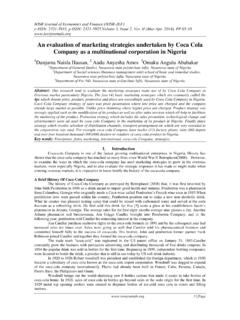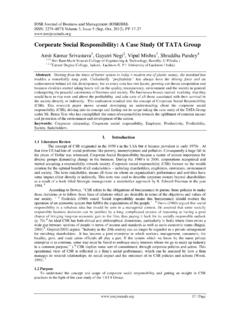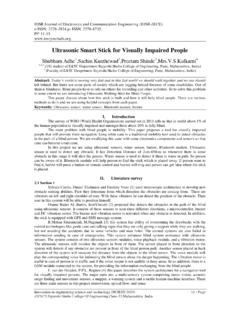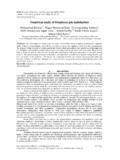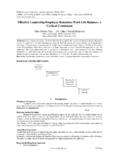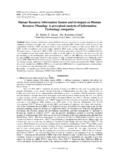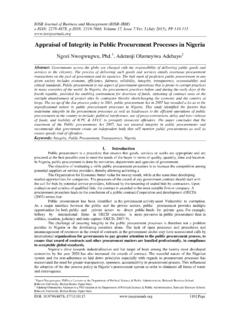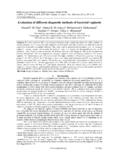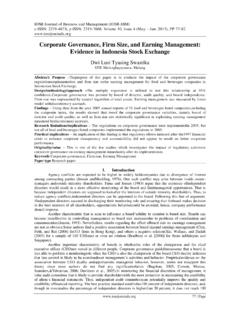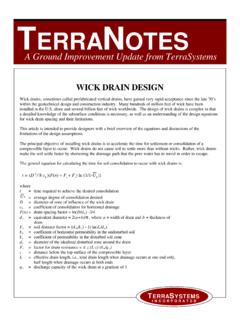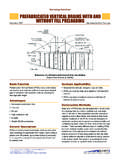Transcription of A Comparison between Horizontal and Vertical Drainage ...
1 IOSR Journal of Mechanical and Civil Engineering (IOSR-JMCE) ISSN: 2278-1684 Volume 4, Issue 1 (Nov. - Dec. 2012), PP 07-12 7 | Page A Comparison between Horizontal and Vertical Drainage Systems (Include Pipe Drainage , Open Ditch Drainage , and Pumped Wells) in Anisotropic Soils Mohammad Valipour Department of Irrigation and Drainage Engineering, College of Abureyhan, University of Tehran, Pakdasht, ABSTRACT : Selecting a proper Drainage system always has been discussed in agricultural or other fields.
2 In anisotropic soils, this problem is more sensitive for experts. In this study, a Comparison has been done between Horizontal and Vertical Drainage in anisotropic soils. For this purpose, using EnDrainWin and WellDrain softwares drain spacing and well spacing, respectively, determined. The results showed that in the same situation, Horizontal Drainage systems due to the higher spacings between drains (reducing number of Drainage and thus reducing the cost) were better than Vertical Drainage systems.
3 However, Vertical Drainage systems due to the lower changes in well spacing in different anisotropic soils were suitable for conditions that soil hydraulic conductivity was likely to change. Keywords: Drain discharge, subsurface Drainage systems design, watertable control I. INTRODUCTION The design of Horizontal and Vertical Drainage in terms layout, depth and spacing of the drains is often done using subsurface Drainage equations with parameters like drain depth, depth of the watertable, soil depth, hydraulic conductivity of the soil and drain discharge.
4 The design of Horizontal and Vertical Drainage systems has been aimed at many researches, which some of them will be described in the following. Geng et al. (2012) presented analytical solutions for a single Vertical drain with vacuum and time-dependents preloading in membrane and membraneless systems. The analytical solutions improved the accuracy of predicting the dissipation of pore water pressure and the associated settlement. Howell et al. (2012) presented centrifuge modeling of prefabricated Vertical drains for liquefaction remediation.
5 Ghandeharioon et al. (2010) analyzed soil disturbance associated with mandrel-driven prefabricated Vertical drains using an elliptical cavity expansion theory. Basu and Prezzi (2010) designed charts for Vertical drains considering soil disturbance. The designed charts could also be used for conditions in which overlapping of disturbed zones occurs. Prasad et al. (2010) estimated unsaturated hydraulic parameters from infiltration and internal Drainage experiments. Marinucci et al. (2010) evaluated the effectiveness of prefabricated Vertical drains using full-scale in situ staged dynamic testing.
6 Singh (2010) survived generalized analytical solutions for groundwater head in inclined aquifers in the presence of subsurface drains. Oosterbaan (2010) survived role of water harvesting and agricultural land development in spate irrigation in the NWFR of Pakistan. Coles (1968) investigated some notes on Drainage design procedure. He showed that various formulas could be solved directly, but graphs have been included to simplify the solution of the different equations. Oosterbaan (1991) studied application of agricultural land Drainage .
7 Oosterbaan (1991) in other research discussed about effectiveness and social/environmental impacts of irrigation projects. Samani et al. (2004) studied flow to Horizontal and slanted drains in anisotropic unconfined aquifers. Youngs (1986) discussed about water-table heights in drained anisotropic homogeneous soils. Barua and Tiwari (1995) presented theories of seepage into auger holes in homogeneous anisotropic soil. Singh et al. (1996) researched unsteady state Drainage in a vertically heterogeneous soil.
8 Endres et al. (2007) compared analytical model predictions and field measurements for pumping-induced vadose zone Drainage and storage in an unconfined aquifer. The delayed Drainage models predicted a relatively rapid dissipation of the undrained storage while the observed undrained storage exhibited little, if any, decay throughout the entire pumping test. Their results indicated that the water table boundary conditions used in these analytical models did not adequately replicate the mechanisms controlling the vadose zone behavior during a pumping test.
9 Luan and Leng (2008) compared monotonic shear behaviors of granular soils under different Drainage conditions. Ali (2011) studied Drainage of agricultural lands as a comprehensive research. O Kelly (2006) compared anisotropy of some soft soils. Gallichand (1994) presented numerical simulations of steady-state subsurface Drainage with vertically decreasing hydraulic conductivity. The results presented could be used to estimate the error on watertable depth resulting from ignoring the Vertical variations of hydraulic conductivity.
10 Hunt (2005) discussed about flow to Vertical and nonvertical wells in leaky aquifers. Choudhry et al. (1995) showed Physical and hydraulic properties of synthetic envelopes for subsurface Drainage in Pakistan. Hanson and Ayars (2002) presented strategies for reducing subsurface Drainage in irrigated A Comparison between Horizontal and Vertical Drainage Systems (Include Pipe Drainage , Open 8 | Page agriculture through improved irrigation. Kannan (2008) Studied drawdown drain discharge relationship and its application in design of Ccost effective subsurface Drainage system in Mugogo Swamp, Busogo, Rwanda.)
